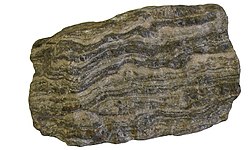Gneiss

Gneiss is a type of metamorphic rock. The minerals in gneiss may come from rocks which were originally either igneous or sedimentary. They were heated and squeezed, and the minerals recrystallized.[1]
Orthogneiss is gneiss got from igneous rock (such as granite). Paragneiss is gneiss got from sedimentary rock (such as sandstone).
In gneisses, minerals tend to be foliated: layered and segregated into bands. Thus there are seams of quartz and of mica in a mica schist, very thin, but consisting essentially of one mineral.
Lewisian gneiss
The Lewisian complex or Lewisian Gneiss is a suite of Precambrian metamorphic rocks that outcrop in the northwestern part of Scotland, forming part of the Hebridean Terrane. These rocks are of Archaean and Palaeoproterozoic age, ranging from 3.0–1.7 Ga.[2]
Gneiss Media
Augen gneiss from Leblon, Rio de Janeiro City, Brazil
Ordovician augen gneiss outcrop, Canigó massif, eastern Pyrenees, France
Dark dikes (now foliated amphibolites) cutting light grey Lewisian gneiss of the Scourie complex, both deformed and cut by later (unfoliated) pink granite dikes
Contact between a dark-colored diabase dike (about 1100 million years old) and light-colored migmatitic paragneiss in the Kosterhavet National Park in the Koster Islands off the western coast of Sweden.
Sample of Sete Voltas gneiss from Bahia in Brazil, the oldest rock outcropping in the crust of South America, c. 3.4 billion years old (Archean)







